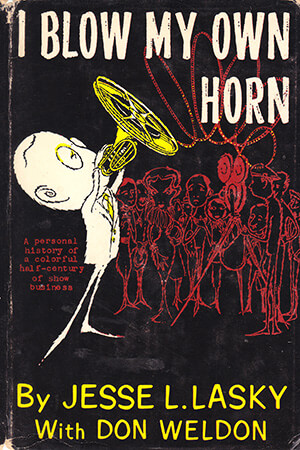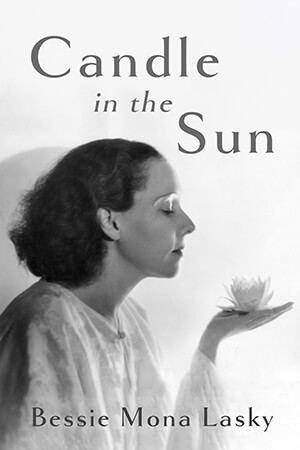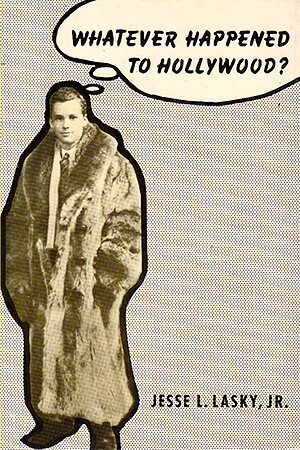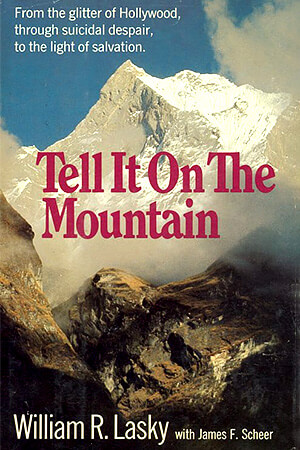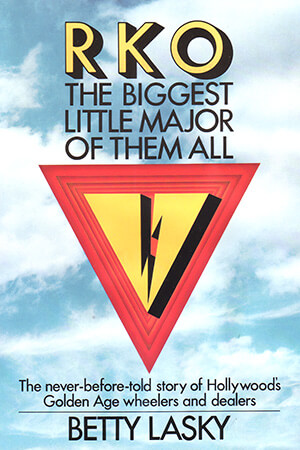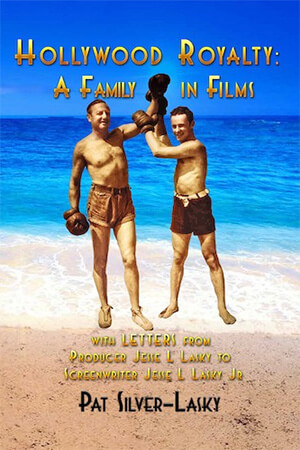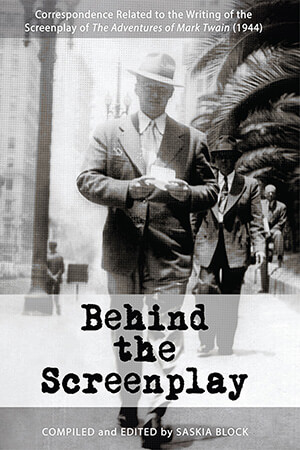Books by or about the Laskys
I BLOW MY OWN HORN by Jesse L. Lasky with Don Weldon [Doubleday & Co., New York, 1957]
[From the dust jacket:] This is Jesse Lasky: one of the founders of the motion-picture industry; the discoverer, promoter of such famous personalities as Ruth St. Denis, Ricardo Cortez, Carole Lombard; Gary Cooper, Spencer Tracy, Bing Crosby; producer of over a thousand movies; for a time one of the eight wealthiest men in Hollywood; and a man who tells all his varied, fabulous, experiences in this, his autobiography.
Oddly enough, Jesse Lasky has always considered himself simply "a frustrated virtuoso, as ecstatically moonstruck in the presence of musical genius today as I was when I was old enough to blow my own horn . . ." For the cornet was Jesse Lasky's first love. As a young man it took him to the Klondike, to Hawaii, to Europe, and throughout the United States. It also led him into show business and later with two other determined young men—Cecil B. DeMille and Sam Goldfish (later Goldwyn)—into a crazy scheme, making motion pictures in, of all places, a Southern California orange grove.
Jesse Lasky's life story is also the history of Hollywood — from the early riotous days of the silent films and their unbelievably garish stars, writers, directors, and producers, to the booming twenties, and on up to the time of that startling new innovation, the talkies. With Don Weldon, movie, TV, and radio writer, Jesse Lasky tells it all with an excitement that recalls the glamour and the temperaments that have made the movies one of the most extraordinary personality-making, money-making industries in the world.
CANDLE IN THE SUN by Bessie Mona Lasky [Kindle; revised and footnoted, Square Circles Publishing, 2019]
First published in 1957, this is the revised and footnoted autobiography of Bessie Lasky—wife of Hollywood founding father Jesse L. Lasky—a successful artist in her own right who wanted nothing more than to escape the glitter and glamor and live in her own simple world of poetry, art and music.
“We lived in separate worlds. But if I had forced her to live in mine, I would have lost her, and that would have been a tragedy for me.” —Jesse L. Lasky Sr., husband
“Her survival—from simple family background, convent education through the glittering towers of material illusions, the halls of Babylon on the Pacific—is a true passage through many mansions. This book holds a priceless message for all who have known the complex loneliness of a crowded world of material frustration. It points like the needle of a compass through the storms of the heart—toward peace of mind.” —Jesse L. Lasky Jr., son
“Bessie was not influenced by Hollywood. Instead, her heart ‘sang gaily of landscapes, still lifes, flower and water subjects.’ In her commitment to her paintbrush, Bessie found the fulfillment not provided by the world of private railroad cars, great houses, servants upstairs and down. . . .” —Betty Lasky, daughter
“When Jesse Lasky first saw Bessie across a room, he recognized her soul shining through her gentle face. Although they scarcely knew each other, within twenty-four hours Jesse had asked her to marry him. She instinctively understood the unique power and intelligence of the man and they were married almost immediately. Wife and husband led extraordinary solo lives, yet there was always an unbroken chord between them. This book reveals the unique essence of a spiritual woman who could express her tranquil soul in paint and poetry and yet play her part as wife and partner to a powerful and exceptionally creative man.” —Pat Silver-Lasky, daughter-in-law, author Hollywood Royalty
THE PATH OF VISION by Bessie Mona Lasky
[The Dryden Press, New York, 1945]
[From the flyer accompanying the book:] The Path of Vision is an exceptional example of craftsmanship in bookmaking, a volume that will be treasured by collectors, art lovers, and connoisseurs alike. The format is large, measuring 101/2" x 12", with fifteen paintings, each measuring 8" x 10" and mounted on right-hand pages facing the commentaries. The reproductions in full color have been made by the Knudsen process, internationally esteemed for fidelity and beauty. The type has been set in Aldine Bembo by The Haddon Craftsmen, who have also printed the text in mat black on Georgian paper. Each painting has been mounted by hand, and each copy bears the artist's signature.
Bessie Mona Lasky made her debut as a painter in 1925, with an exhibition of forty-five oils at the Anderson Galleries in New York City. In the ensuing years, her paintings have been hung in such well-known galleries as the Knoedler Galleries, the Milch Gallery, the Ehrich-Newhouse Gallery, the Durand-Ruel Gallery. Exhibitions have also been held at the Cooling Gallery in London and the Knoedler Gallery in Paris. . . . She has also exhibited by invitation at the Los Angeles County Museum, Legion of Honor S. F., Stanford University, the Albright Art Gallery (Buffalo), the Detroit Art Institute. Thirty of her paintings were included in the International Invitation Exhibition held at the Brooklyn Museum of Art.
WHATEVER HAPPENED TO HOLLYWOOD? by Jesse L. Lasky, Jr. [Funk & Wagnalls, New York, 1983]
[From the dust jacket:] The young boy grew up in a dream world. Hollywood rajahs brooded in their Spanish-style palaces while millions eagerly awaited their next celluloid pronouncements. Stutz Bearcats and Rolls-Royces sailed down Hollywood Boulevard, their riders clad in silks and satins, trailing clouds of mink in the faces of their police escorts. Mock gun battles and lunatic Keystone Cops chases took place in the streets, and over it all hung the dust of unpaved roads and the sweet, pervasive aroma of orange blossoms. . . . Jesse Lasky, Jr., is the son of one of Hollywood's greatest pioneers, and his childhood and adolescence were spent in an era that was as fabulous (and is now as extinct) as the Roman Empire under Nero. With honesty and gusto and in a wealth of anecdotes, Lasky tells of these halcyon days and the Empire's decline and fall, when the stock market crashed, ushering in the hungry thirties, and his father was wiped out overnight. From being the pampered son of one of Hollywood's most powerful men, Lasky was forced to take a job in a hack studio churning out "B" movies. . . . Lasky records his years of struggle to achieve success as a screenwriter. . . . [He] became one of [Cecil B.] De Mille's top scriptwriters, and his stories of working on such De Mille epics as Samson and Delilah and The Ten Commandments could only be Hollywood stories. Whatever Happened to Hollywood? is much more than the history of an era. It is the rich, zestful, fast and funny personal chronicle of one man's journey through an amazing never-never land of make-believe, peopled by con-men, suckers, larger-than-life characters, has-beens and never-has-beens. It's a Hollywood script with a cast of thousands--and it's all true!
TELL IT ON THE MOUNTAIN by William R. Lasky with James F. Scheer [Doubleday and Company, Inc., New York, 1976. ISBN 0-385-11366-8]
[From the book cover:] From the Glitter of Hollywood, Through Suicidal Despair, to the Light of Salvation. . . . His father was the co-founder of Paramount Pictures with a fortune at one time amounting to multi-millions of dollars. His family owned a twenty-room New York City apartment on Fifth Avenue and a California mansion with twenty-seven servants’ rooms and five Rolls-Royces in the garages. There was a lavishly equipped private railroad car to carry them from one coast to the other. Their friends and neighbors as he grew up included Douglas Fairbanks, Sr., Gary Cooper, Marion Davies, and Uncle Samuel Goldwyn. Yet, years later, the day came when William Lasky, in blackest despair, wanted only death. If he could find a means that would not harm others, he would end the life that had become such a burden to him. Then he remembered his childhood governess and her stories of Jesus. He dropped to his knees at his bedside and prayed the only prayer he knew: “Now I lay me down to sleep. I pray the Lord my soul to keep.” Then, looking up, he heard himself saying: “Jesus, help me!” This is the story of how Jesus did.
THE BIGGEST LITTLE MAJOR OF THEM ALL by Betty Lasky [Prentice-Hall, Inc., New Jersey, 1989]
[From the dust jacket:] The story of RKO, the small studio that produced such film giants as King Kong, Citizen Kane, and the Fred Astaire/Ginger Rogers musicals, is now revealed by a woman who grew up among the great stars of Hollywood's "Golden Years": Betty Lasky.
Here you'll find an intriguing tale of executive greed and politics through changing hands, the stock market crash, and the demands of the superstars. This wheeling and dealing produced big money for its financiers, yet, ironically, it seldom tainted the high artistic quality of RKO's films. Immerse yourself in the highly controversial saga of the founders, financial manipulators, creative geniuses, and Hollywood users: Joseph P. Kennedy, Howard Hughes, Louis B. Mayer, David O. Selznick, Cecil B. DeMille, Pandro S. Berman, Floyd B. Odlum, David Sarnoff, Gloria Swanson, Orson Welles, Edward F. Abee, Merian C. Cooper, Dore Schary, and, of course, film pioneer Jesse L. Lasky.
Illustrated with nearly 100 behind-the-scenes photos, including some depicting the making of such films as Cimarron, Top Hat, The Magnificent Ambersons, and The Hunchback of Notre Dame, RKO, The Biggest Little Major of Them All is sure to engross film buffs, film historians, and business experts alike.
HOLLYWOOD ROYALTY by Pat Silver-Lasky [BearManor Media, Albany, GA., 2017. ISBN: 978-1629331843]
[From the BearManor website:] Discover a unique, family perspective of American film history through a 1921 to 1949 archive of 435 letters written by pioneering film producer Jesse L. Lasky. His triumphs and failures—and the family that traveled with him—provide an illuminating, insider view of the day-to-day creation of the film industry, including behind-the-scenes negotiations and developments with Adolph Zukor, Samuel Goldwyn, Cecil B. DeMille, and the making of such early classics as The Squaw Man (1914), The Sheik (1921), The Covered Wagon (1923), Peter Pan (1924), The Cocoanuts (Marx Brothers) (1929) and later benchmarks as Sergeant York (1941), The Adventures of Mark Twain (1944), and Rhapsody in Blue (1945). An innovator, Lasky’s letters reveal a producer’s point of view on working with his partner Cecil B.DeMille; with discoveries Gary Cooper and Marlene Dietrich in an early talkie film; his rivalry with producer Sam Goldwyn; Gloria Swanson, who once refused his $17,500-a-week contract; and Hollywood’s legendary king and queen, Mary Pickford and Douglas Fairbanks. Lasky's complex relationship with his wife, the fatherly advice he offered to Jesse Jr., whose significant role in Hollywood's wartime activities, are spotlighted in thrilling recollections, anecdotes, and fascinating photos from the family's personal collection. Includes a complete list of more than a thousand films produced by Jesse L. Lasky and the 48 films written by Jesse L. Lasky Jr.
BEHIND THE SCREENPLAY: Correspondence Related to the Writing of the Screenplay of The Adventures of Mark Twain (1944) Compiled and Edited by Saskia Block
[Square Circles Publishing, Pahrump NV, 2017, Print ISBN: 978-0998255644; Kindle ISBN: 0998255645]
This book is made up of letters that document what went on behind the scenes in writing the screenplay of the 1944 Warner Bros. film, The Adventures of Mark Twain. The main correspondents are New York playwright and author Harold M. Sherman, Mark Twain Estate attorney Charles T. Lark, the film’s producer Jesse L. Lasky, and Mark Twain’s daughter Clara Clemens Gabrilowitsch. In 1936 Sherman had been granted exclusive dramatic rights to the Twain story for a limited time by the Mark Twain Estate, and in the process became close friends with Clara Gabrilowitsch. The letters begin with an option agreement between Lasky and Sherman for Sherman to write a preliminary treatment for shopping the proposed film around to major studios. They go on to detail the unfolding relationships among the four main correspondents -- how Lasky dealt with the ambitious but inexperienced Sherman; how Sherman had to swallow his pride when Lasky replaced him with big-name Hollywood writers; how the Sherman-Gabrilowitsch friendship disintegrated as Clara’s dissatisfaction with the contracts and the final script led her to file suit against the trustees of her own estate; and how Lasky and his wife Bessie formed a personal relationship with Harold and Martha Sherman, while maintaining a professional distance.

